Nycticebus javanicus
The Javan Slow Loris

Beauty, a gift or a curse? For the Javan slow loris, having such loveable appearance is by no doubt a deadly curse. With huge innocent eyes and a teddy-bear-like figure, this species of primate is popularly traded in illegal pet trades around the world. Due to possessive desires of selfish pet buyers, the Javan slow loris has been listed as one of the 25 most endangered primate in the world since 2008. Starting off with the short clip below, embark on a journey to learn about this cute creation of nature in detail and discover more on its unfortunate fate in our world today.
Table of Contents
Javan slow loris being sold in Barito Animal Market, Jakarta, Indonesia. Video by Kimberly Ng.
Overview
Often being mistakenly categorized as squirrel-like animals, Javan slow lorises are actually primates that live an arboreal lifestyle. This species of slow loris belongs natively to the Java Island of Indonesia. However, due to its involvement in illegal pet trades, its presence is now widely spread throughout the world, including Singapore. Nycticebus javanicus can be distinguished from other slow loris species by its distinct facial marks. Like other slow lorises, this animal possesses a unique trait of delivering toxic bites when agitated. Besides that, they are also equipped with large eyes to help foraging in the dark as they are nocturnal animals that are active only when night arrives. Unfortunately, it is also these eyes that give them an adorable appearance, thus attracting a miserable fate to arise. People from around the world yearn to own this cute creature, causing the occurrence of extensive poaching to feed demands of exotic pet trade markets.
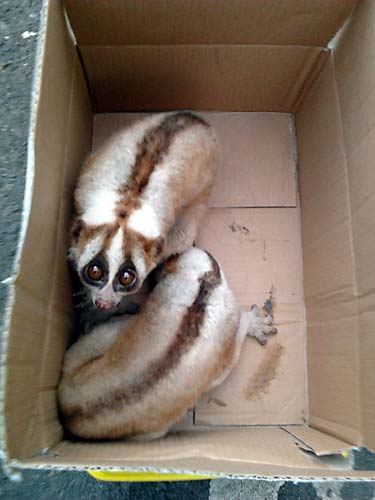 |
| Despite being protected, Javan slow lorises are frequently illegally traded on the streets of Jakarta. Photograph courtesy of TRAFFIC. |
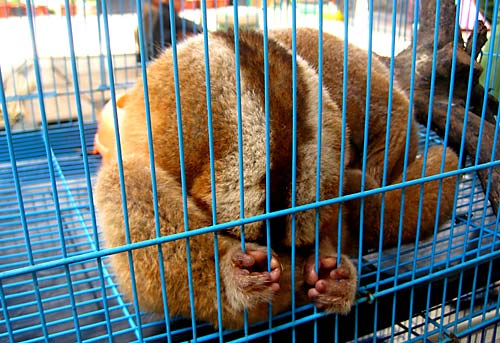 |
| A slow loris being caged and waiting to be sold. Species unknown. Photograph courtesy of TRAFFIC. |
Consequently, the numbers of wild Javan slow lorises plunged drastically over the years, so do the population of other slow loris species. The worst has yet to come. Habitat loss and superstitious beliefs that regard this primate as a cure for various illnesses have also brought further impact to the population of this poor animal in the wild. Globally, law enforcement has been introduced to forbid all trading of the Javan slow loris. Conservation efforts have also been carried out to lessen the negative impacts on this endangered species. However, the public should play a role to help conserve the Javan slow loris. The first simplest step is to refrain yourself from purchasing a slow loris. When there is no demand, the supply of by poaching would just cease by itself. Owning a slow loris for your personal usage and well-being is a selfish act that would cause you to face legal sentences.
Possession is certainly not a way to display affection. If you truly adore the Javan slow loris, then set it free.
Back to Top
Etymology

Nomenclature of Nycticebus javanicus. [1]
Why the name Nycticebus javanicus? A quick grasp of its name would help to reveal more about this species.
- Genus name Nycticebus = night monkey in Ancient Greek. This means Javan slow lorises are a group of nocturnal primates. [2]
- Species name javanicus = Java, an island belonging to Indonesia. This tells us that the Java Island is where it is natively found.
Taxonomy
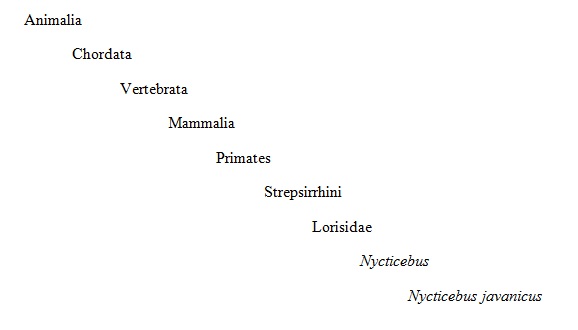 |
Looking into the scientific classification of Javan slow lorises, they fall under the primate group. [3] One of the most important distinguishing features of primates is the evolution of opposable thumbs. However, it should be noted that not all primates have opposable thumb, and not all animals with opposable thumb fall under the primate group. Slow lorises are among the primates that have opposable thumbs. This allows them to have the dexterity and ease for grasping items. Observe below on how a slow loris uses its opposable thumb to handle its food. |
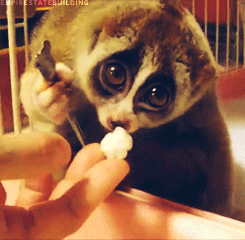
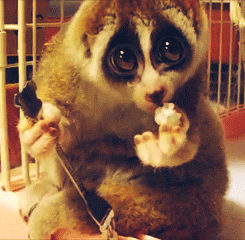
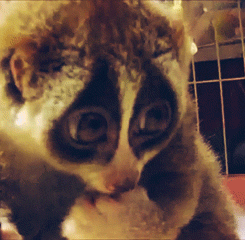
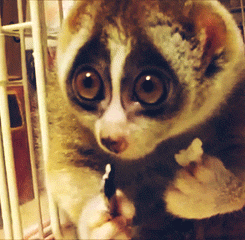
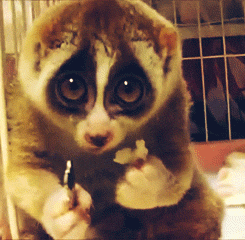
A slow loris using its opposable thumb to pick up food and place it into the mouth. Species unknown. Photographs edited from YouTube video.
There are 5 species of slow lorises grouped under Nycticebus. [4]
Nycticebus bengalensis (Bengal slow loris)
Nycticebus pygmaeus (Pygmy slow loris)
Nycticebus coucang (Greater slow loris)
Nycticebus menagensis (Bornean slow loris)
Nycticebus javanicus (Javan slow loris)
All 5 species of slow lorises are victims of exotic pet trade throughout their range, causing their numbers in the wild to decline in an alarming rate. However, when combined with tremendous habitat loss, no other species has been harder hit than the Javan slow loris. [5] The IUCN (International Union for Conservation of Nature) has listed Javan slow lorises the status of being endangered, whereas the other 4 species are considered vulnerable.
 |
| Categories of IUCN Red List status. Javan slow lorises fall under the status of endangered. Figure from IUCN Red List. |
Nycticebus javanicus, the Javan slow loris was first described scientifically by Geoffroy in 1812. Its taxonomic status has since been changed several times. [6] The most recent revision promoted this group of animal to the species status again, based on an analysis of skull morphology and fur characteristics. [7] Below shows the series of changes in taxonomic status of Nycticebus javanicus over the years. [8]
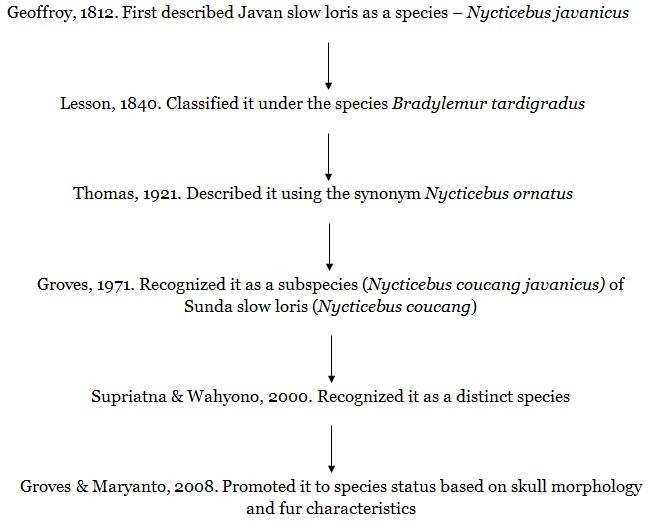
Identification
How can the Javan slow loris be distinguished from the other 4 species just by examining their physical features? The most obvious difference is the presence of a white diamond pattern between the eyes of Javan slow loris, extending towards its forehead. [9] The images below depict the overall differences in facial masks among the 5 species of slow loris.
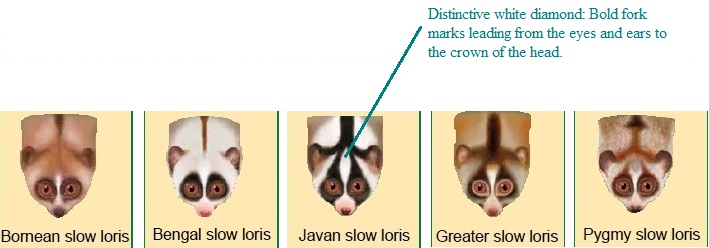 |
| Differences in facial markings among the 5 species of slow lorises. Figure courtesy of Anna Nekaris. |
Besides the distinctive white diamond pattern, there are several other physical characteristics of the Javan slow loris that can be used to differentiate it from the other 4 species. These differences are based on characteristics of its pelage, or fur. [10]
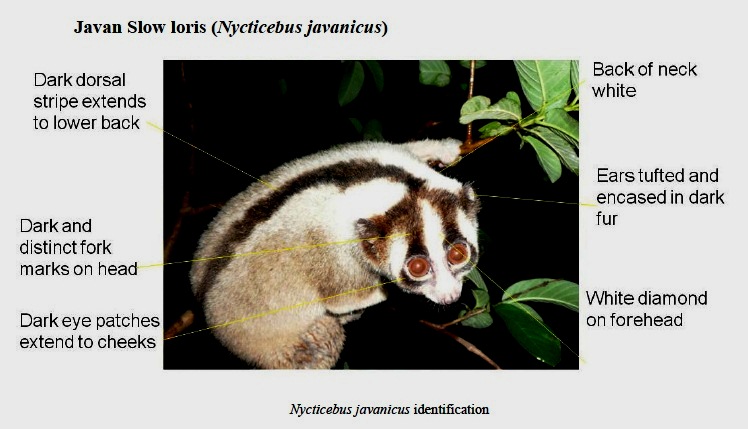 |
| Further identification traits of the Javan slow loris. Photograph courtesy of International Animal Rescue. |
Distribution
In addition to the physical differences mentioned, the Javan slow loris also has a distinct range of distribution where it can be found. As its name implies, this species of slow loris is endemic to the Java Island of Indonesia. This implies that wild Javan lorises are only present in that island, specifically Central and West Java. The fact that this species of slow loris is a Javan endemic animal threatens its existence. This is because with such a narrow range of existence, Javan lorises can easily be driven to extinction. Loss of habitat in the Java Island has caused this species to have a drastic decline in numbers. On the contrary with wild Javan slow lorises, those in captivity are not only confined in the island of Java. They can be found in Prague (Czech Republic), Jakarta (Indonesia) and Singapore. [11] These captive Javan lorises are present in the zoos of the mentioned countries.
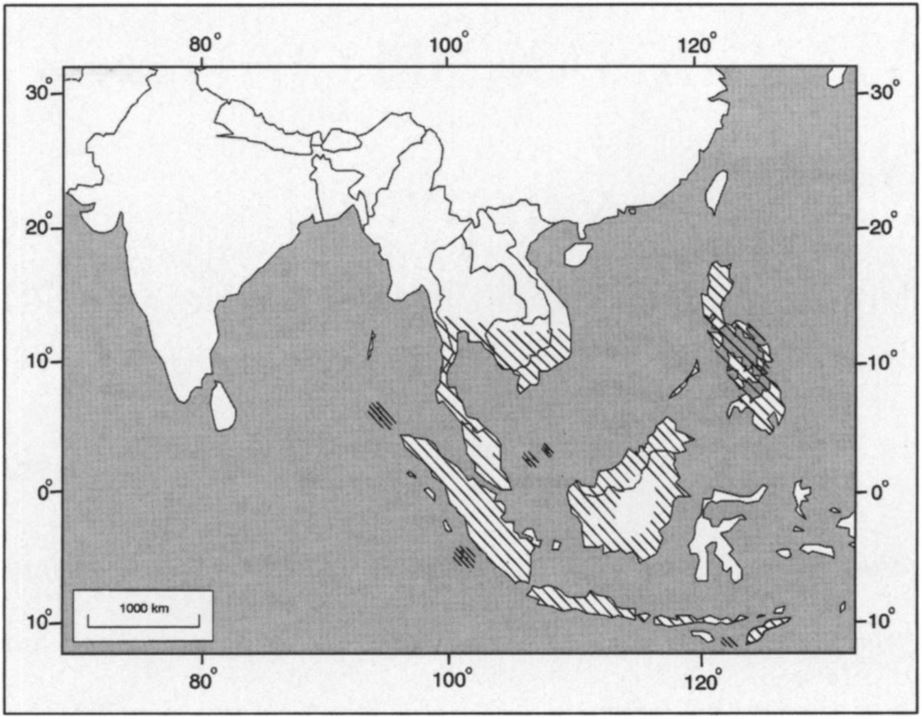
Back to Top
Presence in Singapore
Zoo Captivity
Although the Javan slow loris is an endemic species that came from Java, it can now be found locally in Singapore. Currently, there is one male and one female Javan slow loris under the guardianship of Wildlife Reserve Singapore (WRS). However, they are not on exhibit for the public. One of the Javan slow loris was donated by the public, while the other was confiscated by AVA (Agri-Food & Veterinary Authority of Singapore). Fortunately, these Javan slow lorises were not suffering from any injuries that are usually seen in slow lorises involved in the trading market.[13]
Back to Top
Illegal Captivity
Exotic pet trades are on the rise in Singapore, and those trades often involves the slow lorises. Due to close proximity to the Java Island of Indonesia, there is a high probability that local pet traders are importing Javan slow lorises into Singapore. Media release reports on illegal animal seizures by Agri-Food & Veterinary Authority of Singapore (AVA) shows that slow lorises are among the common animals confiscated. [14] With the advent of internet, communication among people from different countries has become feasible. Geographical barriers are no longer a hurdle for illegal tradings. It has been recorded that there are cases of people in Singapore trading slow lorises trough the internet or online platforms.
In the year of 2007 to 2008, a Singapore slow loris biologist, Mr. Fam Shun Deng (Msc in Primate Conservation) did a field, museum, and trade study of slow lorises in Singapore. He has depicted the involvement of Singapore in international illegal slow loris pet trades. It was found that from the year2006 onwards, the trend of slow loris confiscation numbers follows the trend of international confiscation numbers of the slow lorises. This shows a high correlation between the international trading and the local trading in Singapore. This also suggests that Singapore might be a transit point between range states and client states of the trade market. [15] With such involvement in the international trading market of slow lorises, it is no surprise that the Javan slow loris might be found at Singapore homes, in the hands of illegal pet owners.
Due to the substantial volume of human and cargo traffic entering and exiting Singapore daily, it is practically impossible for AVA and ICA (Immigration & Checkpoints Authority of Singapore) to inspect every single container that is shipped in, or is in transit through this island. Thus, instead of solely relying upon authorities that have imitations in executing their powers, the public should also take responsibility to deter such illegal tradings.
Please do not get involved in the pet trading of Javan slow loris, and other slow lorises. Legal prosecutions will be sentenced if you are found keeping any slow lorises or other wild animals illegally.
Maximum penalties include a fine of $5,000 (or $10,000 for repeated offenses) and/or a jail term of up to 1 year
Back to Top
In the Wild
It is found that the wild slow lorises seen in Singapore do not consist of the native species (Nycticebus coucang) only. Wild slow lorises present in Singapore live in a mixed native-exotic population, implying that there is a possibility that Javan slow lorises are present locally in the wild. How did the Java endemic Javan slow loris ended up in Singapore if it is not in captivity? This might be due to pet release by irresponsible pet owners.
According to the findings by Mr. Fam, there is also a correlation between internationally confiscated slow loris numbers and locally sighted slow loris numbers. This indicates an influx of illegally traded slow lorises followed subsequently by the possible release of these lorises to the wild. [16] In Singapore, release of pets to the nature reserves has become an escalating problem to native species. For various reasons, such as when taking care of a slow loris becomes a burdening task, irresponsible pet owners tend to release these poor animals to the wild. If you intend to release your Javan slow loris, or other slow lorises to the wild, please do not do so. Mixing native and exotic species of slow loris will cause harm to both parties and complicate conservation efforts. Hand them in to the authorities instead. Similarly, if there are sightings of wild Javan slow loris or other slow lorises in the Singapore, please try to capture a photograph of the animal and report it to the authorities in charge..
- The ACRES (Animal Concerns Research & Education Society) Wildlife Crime Hotline at 97837782
- The AVA (Agri-Food and Veterinary Authority) at 62770670
- Mr. Fam Shun Deng (MSc in Primate Conservation) at 92215549
Back to Top
Biology
Venomous Bite
Despite being morphologically different from the other species, Javan slow lorises have the same unique ability as other slow lorises in delivering a venomous bite. Slow lorises have a brachial gland located near their elbows. This gland secretes a strong smelling liquid that is toxic. When threatened, secretion of this liquid occurs. The slow lorises will then lick this liquid to mix it with their saliva, thus activating the toxins from the brachial gland. Following that, they tend to defend themselves by biting into what threatens them, for example a predator. Sharp incisors of the slow loris can easily puncture an animal’s skin, thus delivering the toxin to the bloodstream of its predator. This toxin is termed venomous because it enters the victim's body through injection into bloodstreams, unlike poisonous substances that enter through ingestion or inhalation. [17]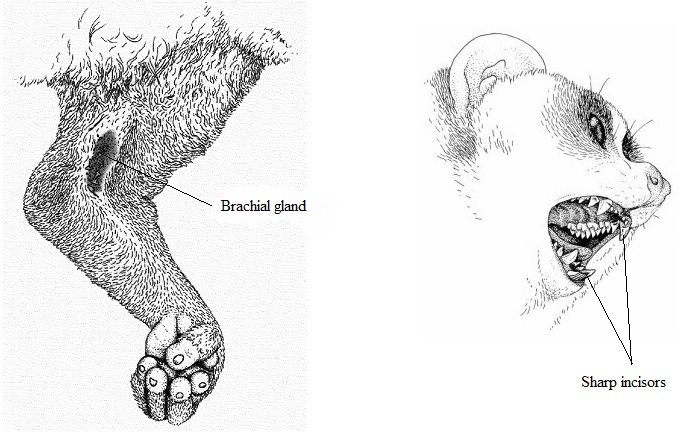
Being bitten by these adorable and seemingly harmless creatures is no laughing matter. Slow lorises tend to bite and hold on. This is because the longer they bite, the more toxin will be delivered into the victim's bloodstream. Victims of the venomous bite can develop anaphylactic shock symptoms like itch of skin, convulsion of muscles or even respiratory problems. In addition to that, wounds from these bites heal in a considerably slow manner. This is because the mouths of slow lorises contain a myriad of bacteria that would dampen the healing process of the wound. It is found that this toxic substance produced by brachial organ proteins are similar to the cat allergen Fel d 1. This explains the occurrence of anaphylactic shock symptoms in victims of the venomous bite. [18]

Slow lorises are the only venomous primate in the world. Blessed with this powerful weapon of defense, slow loris mothers would often lick and spread the salivary toxin onto their young ones. This acts as an additional barrier of protection to young slow lorises, just in case their mothers are caught off-guard by predators. Besides guarding itself from predators, it is also suggested that the lorises make use of their venomous bites against parasites, prey or even other lorises.
Back to Top
Behavior and Diet
Like other slow lorises, the Javan slow loris moves in a rather cautious motion. Often, they are not found leaping and swinging across tree branches like how we thought a primate would do. Instead, they travel by deliberate and precise movements that resemble crawling.
A slow loris moving up tree branches with deliberate movements. Species unknown.
The slow pace of life practiced by the slow lorises is mainly due to their low metabolic rate. [19] It is thus believed that the illegal poachers take advantage of this slow movement to capture the slow lorises almost effortlessly. However, contrary to this belief, slow lorises can sometimes be capable to move rapidly when threatened. If so, how do the poachers catch the slow lorises when there is a high chance of losing track on them? The way poachers capture the slow lorises is by co-operating with the loggers. Being nocturnal, slow lorises are asleep in the day when the loggers carry out their logging activities. The loggers will intentionally collapse trees with slow lorises on them. When the slow lorises are stunned, they tend to stay still and thus undergo a crypsis stage. The poachers then come into act and shuffle through the foliage to simply pick up the stunned lorises. [20]
The reason slow lorises have a low metabolic rate is because of their dietary habits. Similar to other slow lorises, Javan slow lorises are omnivores that consume various kinds of food. Nectar, plant gums and fruits are the common diet of slow lorises. These plant components contain hard-to-digest secondary substances, thus the need of devoting more energy to digest these foods. Consequently, less amount of energy is channeled to maintain the hence low metabolism. It is also found that slow lorises eat poisonous insects like ants and millipedes to obtain the chemical constitutions needed for supplying their venomous toxin. The ingestion of these toxic animals requires more energy as well because they contain digestion-inhibiting compounds. [21]
Being a nocturnal animal, this species of primate carries out active foraging only at night. To be able to forage effectively in the dark, their eyes are large and comprise of a reflective layer, called the tapetum lucidum that improves low-light vision. Sadly, this huge-eye-adaptation that confers them night vision advantage is the main cause of them being perceived as cute pets that are popularly wanted across regions.
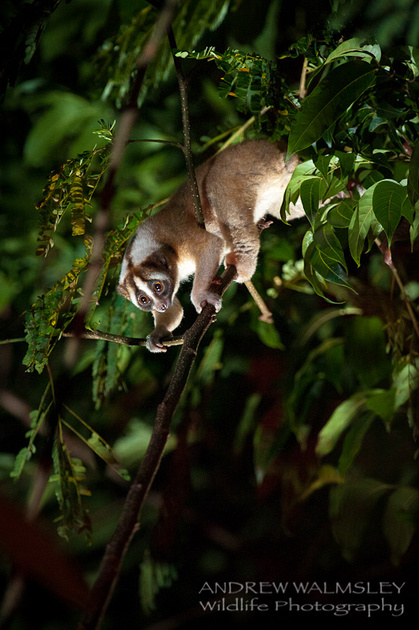 |
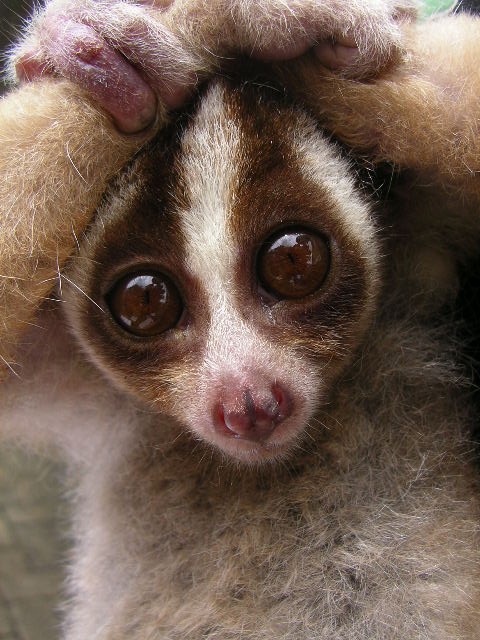 |
| Javan slow loris actively foraging when the night arrives. Photograph courtesy of Andrew Walmsley. |
Huge, round eyes of the Javan slow loris add advantage to vision in the dark. Photograph courtesy of Anna Nekaris. |
Krik sounds emitted by a slow loris that is believed to be kept illegally as house pet. Species unknown.
Back to Top
Threats
Illegal Pet Trade
Despite the risk of being bitten by the venomous bite of Javan slow lorises, the poaching activities on these animals are still on the rise. Wild Javan slow lorises are caught illegally to supply the infamous exotic pet market in Indonesia. The public perceives these slow lorises as adorable pets that can be domesticated to keep them company. Little did they know, their selfish act of owning the Javan slow lorises has caused this animal to face extinction risks. To make situations worse, the pet market in Indonesia does not seem to be the only platform for Javan slow lorises pet trade. These animals are also widely trafficked across the world by other convenient methods like online trading.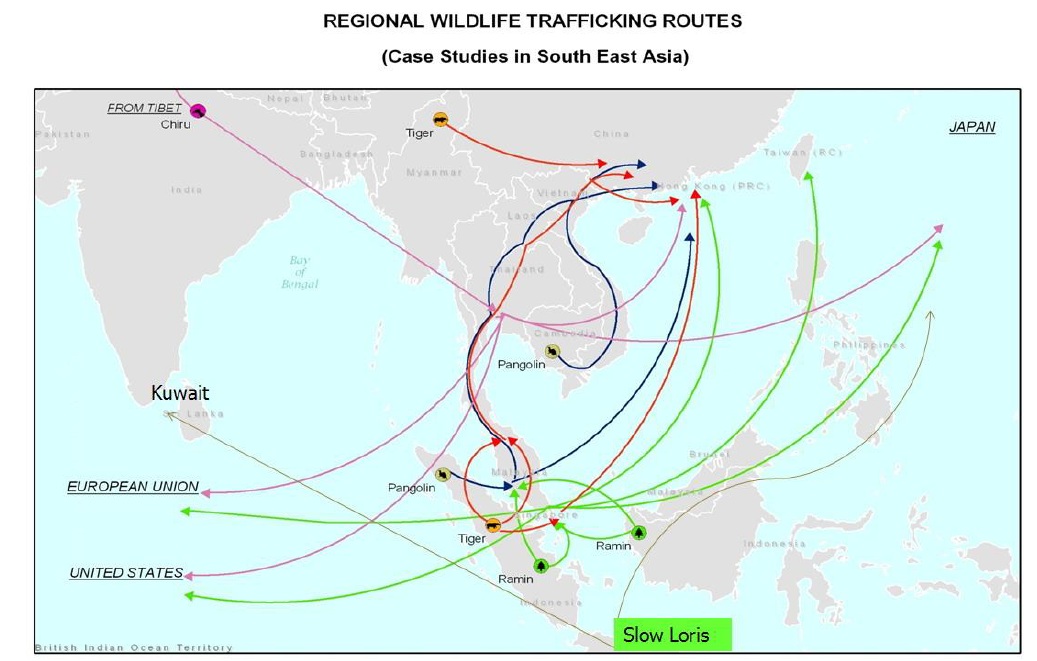 |
| Slow loris illegal trafficking route stretches from far west to far east of the globe, causing a sharp decline of these animals in the wild. Figure courtesy of International Animal Rescue. |
The highest levels of illegal slow loris international trade are recorded from Laos, Cambodia and Thailand. This is followed by Singapore and Malaysia. Singapore is the only significant re-exporter of this trade, with Japan as its main trading partner. The main importers are from Japan, United States and Europe. Indonesia and China are more involved in illegal domestic trades. [24]
The numbers of Javan slow loris in animal markets far exceed the ability for population numbers to recover in the wild. Besides the extensive pet trade on-going in Indonesia, the slow reproduction rate of these animals also add on to the slow recovery in the wild. This poses an extinction threat to this species of slow loris. The dark side of this illegal pet trade has not ended yet. Not only do they lost their freedom in the wild, Javan slow lorises also lose their lives in the process of these illegal trades. In order to domesticate the wild Javan lorises, merciless traders would forcefully remove the teeth of these animals using sharp objects like nail clippers. This cruel act causes the poor animals to suffer from stress and infection that would most probably lead to a painful death. Not only the Javan species, other slow lorises also die from dental abscesses, pneumonia or malnutrition as a result of their forceful teeth removal in illegal pet markets. Even if they were to be relocated into rehabilitation centres, the chances of them surviving in the wild are rather slim. This is because they could no longer eat their preferred diet or carry out social behaviors after their teeth is removed. [25]
Besides pulling off their teeth, traders in Indonesian markets also treat slow lorises with other awful acts. As mentioned, slow lorises tend to hold on their bites once they plunged their incisors to deliver the salivary toxin. Due to this reason, the traders are sometimes prepared with big vats of water and if they are bitten, they will dunk the slow lorises into the water to get it release is bite.
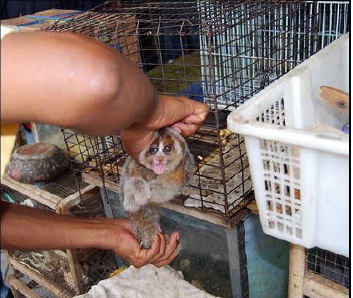 |
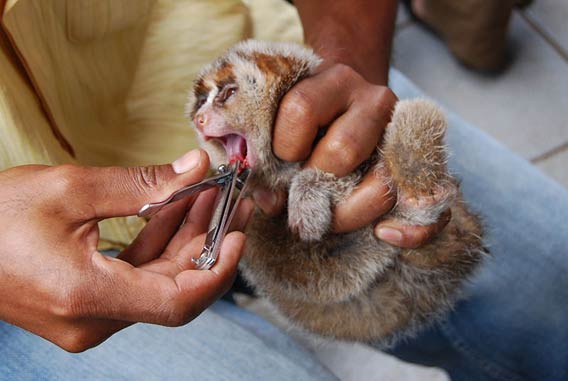 |
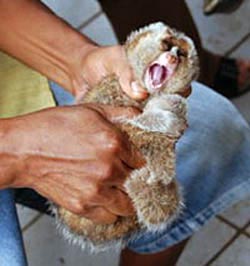 |
| A slow loris being harshly handled during the trading process. Photograph courtesy of International Animal Rescue. |
A slow loris having its teeth forcefully and painfully removed using a nail clipper. Photograph courtesy ofInternational Animal Rescue. |
A slow loris in an extreme distress state during the trading process. Photograph courtesy of International Animal Rescue. |
| Tragic scenes captured in Jakarta's animal market. Numerous slow lorises caged to await for trading despite being protected by the Indonesian law. Video by Anna Nekaris. |
Back to Top
Habitat Loss
There is extensive human land-use in Java. This causes the current forest cover to be unable to sufficiently support the expanse of Javan slow loris habitat. Data on geographical ranges found that the high human land-use densities and human disturbance in Java are rather risky to maintain viable populations of the Javan slow loris. Studies have also reveal the vulnerability of Javan slow lorises to anthropogenic activity to be significantly more than other slow loris species. This shows that they have lower tolerance towards human disturbance. Loss of habitat hinders the Javan slow lorises to forage and carry out daily activities, which would gradually drive this species to extinction. [26]Back to Top
Sold as Medicinal Cure
Traditional beliefs have largely exploited almost the entire body of slow lorises for medicinal cure. These practices have created another huge illegal trade market for the slow lorises, which further promotes the poaching on these animals. These beliefs that carry no scientific evidences add to the reduction of slow loris numbers, threatening their existence in the wild. CITES (Convention on International Trade in Endangered Species of Wild Fauna and Flora) has revealed the usage of slow lorises in these customary practices. [27]• Fur: in Traditional Asian Medicine, believed to support wound healing, worn as amulet by local Indonesians locally to ward off danger.
• Eye-balls: as love potion
• Flesh: to cure epilepsy
• Meat: to cure stomach ailments or asthma
• Whole body in alcohol: used as “energy drink”
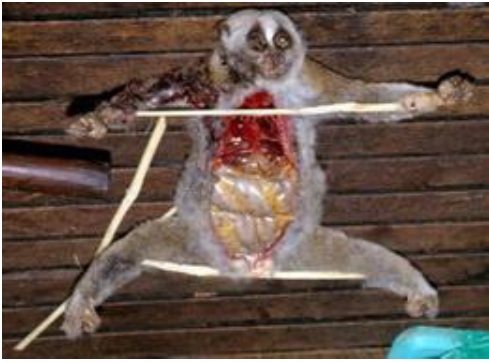 |
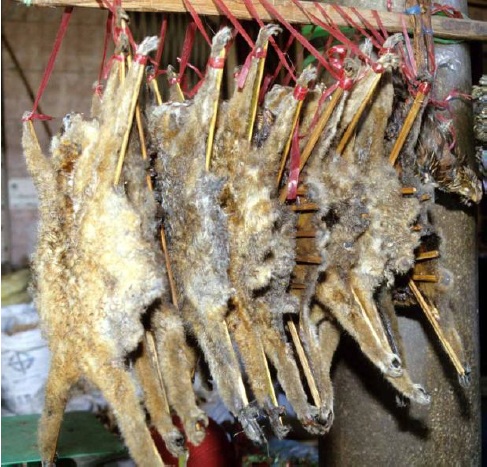 |
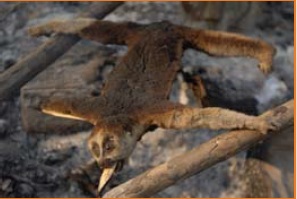 |
| Slow loris dissected. Its organs are used for traditional medicine. Photograph courtesy of International Animal Rescue. |
Numerous dried slow loris being sold for remedial purposes. Photograph courtesy of International Animal Rescue. |
Slow lorises are also smoked to be offered in markets. Photograph courtesy of Anna Nekaris. |
Conservation
Status and Ongoing Efforts
Conservation statuses allow the parties involved to recognize the severeness of a species towards extinction. They help in planning for conservation measures to alleviate the threats faced by a species. Below are the conservation statuses of Javan and other species of slow loris.| IUCN Red List |
endangered [28] |
| CITES |
elevated from Appendix II to Appendix I, offering it increased protection from commercial trade, higher fines and stronger international efforts [29] |
| IUCN Species Survival Commission Primate Specialist Group (IUCN/SSC PSG), the International Primatological Society (IPS), and Conservation International (CI) |
The World's 25 Most Endangered Primates (since year 2008) [30] [31] |
| Indonesian law |
illegal to own and trade slow lorises. Unfortunately, effective law enforcement with respect to wildlife protection laws is all but non-existent in Indonesia [32] |
| Singaporean law |
illegal to own and trade slow lorises. Maximum penalties include a fine of $5,000 (or $10,000 for repeated offenses) and/or a jail term of up to 1 year [33] |
| International law |
illegal to own and trade slow lorises, due to CITE Appendix I status which is an international agreement between governments |
| International Animal Rescue |
- established a facility specializing in the care of slow lorises in Ciapus, West Java - currently caring for nearly 100 slow lorises that have been surrendered by their owners or confiscated from the illegal wildlife trade - animals undergo treatment, rehabilitation and socialization in preparation for release back into the wild - However, many of the lorises have had their teeth cut out and therefore may no longer be able to fend for themselves. - Working with veterinary dental specialists to determine whether their teeth can be repaired or replaced. |
| Little Fireface Project * Certain areas in Singapore might not be able to gain access to this website. Please try again to access in other areas of Singapore if access is prohibited in your current area. |
- Aims to save these primates from extinction through learning more about their ecology - Aims to use this information to educate local people and law enforcement officers,leading to empathy and empowerment whereby people in countries where lorises exist will want to save them for themselves. - This is done through education, media, workshops and classroom programmes. - Education does not stop in range countries, but also reaches out to potential western purchasers of loris pets. |
Back to Top
Play Your Part
Simple ways to help the Javan and other species of slow loris:
- Do not keep slow lorises as your pet
- If you really want a pet, get a dog or other domestic animals instead, by legal means
- Do not get involved in any trading or trafficking of slow lorises
- Report to the authorities if found any illegal activities concerning the slow lorises
- The ACRES (Animal Concerns Research & Education Society) Wildlife Crime Hotline at 97837782
- The AVA (Agri-Food and Veterinary Authority) at 62770670.
- Spread the message across social platforms to help in conservation efforts
- If by chance, you stumble upon slow lorises in urban settings or find them abandoned in boxes, try calming it down by handing over a sturdy stick for it to hold onto. These animals are arboreal, thus they have a natural instinct of grasping onto something. A sturdy stick would aid in comforting them.
- If you happen to spot a slow loris and intend to take a picture of it to report to the authorities, please do not shine bright lights or flash your camera lights towards the direction of the slow loris. The structure of their eyes are suited for night vision and hence they would be uncomfortable when exposed to brightness.

Back to Top
Poll - Contribute Your Votes!
To possess or to conserve? Reflect your thoughts simply by casting a vote below.
Knowing the Javan slow loris is listed as an endangered species, do you still desire to keep them as pets?
If you have any additional information or useful thoughts that you would like to share, please feel free to comment on this page (click on "discussion posts" at top right corner) or drop an email to suktengchin@gmail.com
Back to Top
Phylogeny
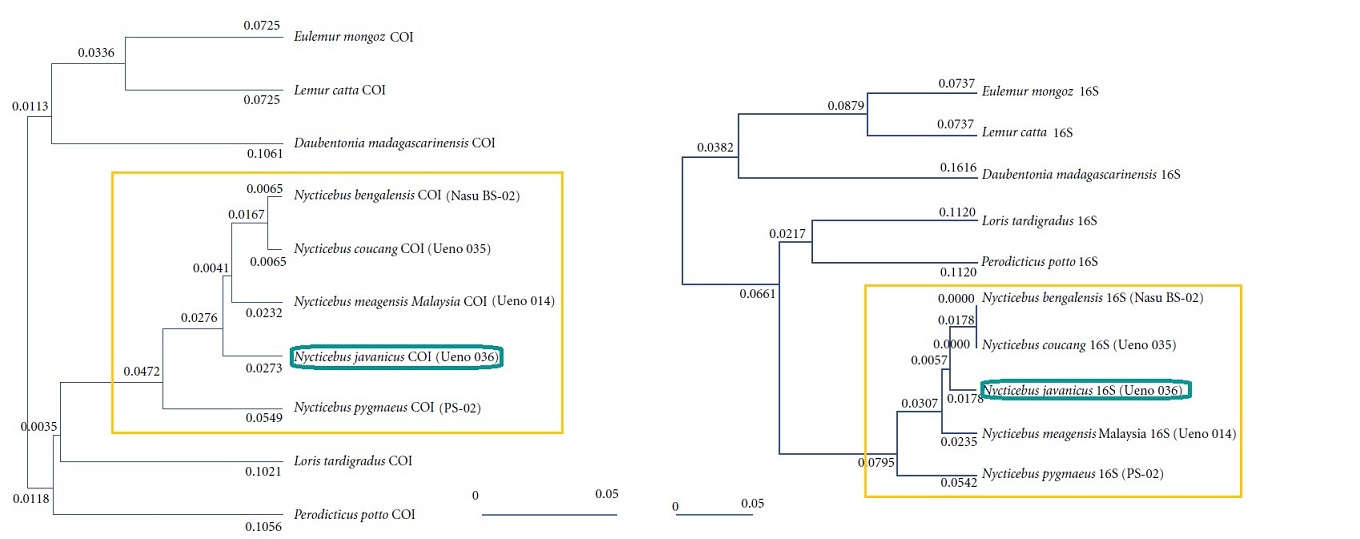 |
| Distance matrixes of 16S rRNA and COI region of loris species. Numbers of nodes represent means of pair-wise evolutionary distances. Figure courtesy of Somura et al., 2011. |
The phylogenetic relationship between Nycticebus javanicus and the other species is depicted differently when different regions of the mitochondrial DNA is used for analyses. Further sequence data are to be explored for more solid resolve of their relationship. [34]
Nevertheless, this obtained result aids to identify each of the 5 species for conservation purposes as physical differences can be rather hard to tell apart at times. Slow lorises that are confiscated are protected and there is a need to distinguish among species to ease rehabilitation efforts. In most cases, the country of origin remains unknown and even the species can be difficult to identify from the animal’s physical appearance alone. DNA analysis can then be used to resolve this problem.
Back to Top
Scientific Description
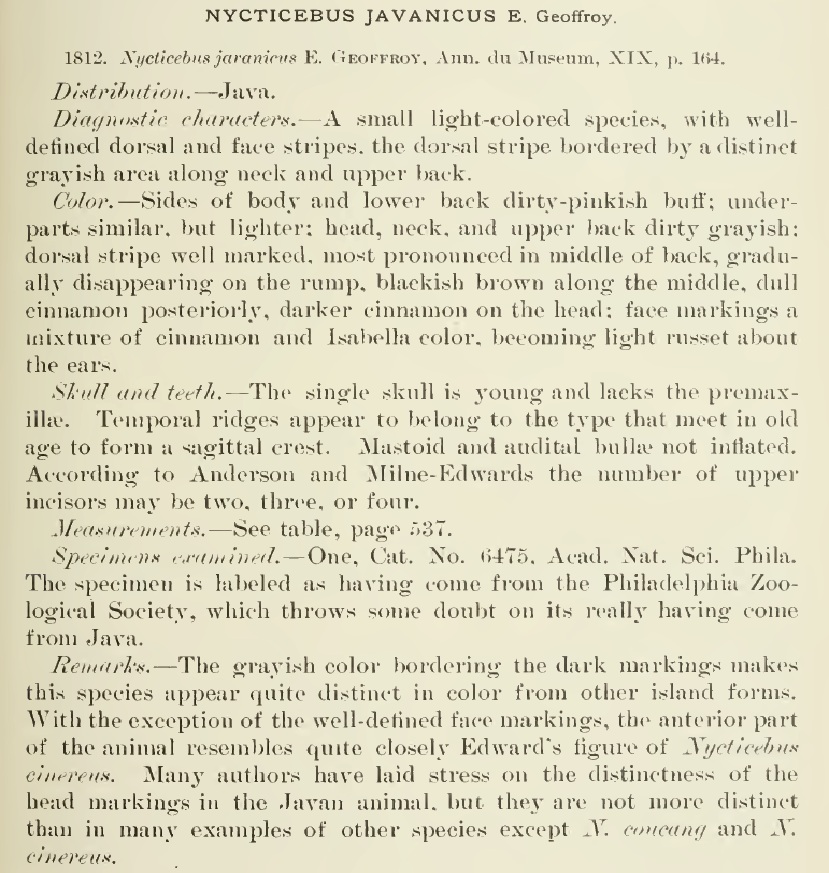 |
Type Information: Nycticebus javanicus was first described by Étienne Geoffroy Saint-Hilaire in 1812. The holotype of this species is kept in the Annales du Muséum National d'Histoire Naturelle of Paris, France. [35] A holotype is the representative specimen selected by the original describer to describe a species or subspecies. Holotypes and their original descriptions are important documentations used to resolve disputes on the classification of the species. They are also useful to confirm the identity of an uncertain specimen and its taxonomic issues. Type locality: Java, Indonesia |
Back to Top
References
Nekaris, K.A.I. & M. Shekelle, 2008. Nycticebus javanicus. In: IUCN 2012. IUCN Red List of Threatened Species. Version 2012.2. Retrieved 6 November 2012, from IUCN Red List.
Encyclopedia of Life, 2012. Taxonomic information for Javan slow loris. Retrieved 5 November 2012, from Encyclopedia of Life.
Nekaris, K.A.I., G.V. Blackham & V. Nijman, 2008. Conservation implications of low encounter rates of five nocturnal primate species (Nycticebus spp.) in Asia. Biodiversity Conservation, 17: 733–747.
Nekaris, K.A.I., K.L. Sanchez, J.S. Thorn, I. Winarti & V. Nijman, 2008. Javan Slow Loris. Indonesia. Retrieved 7 November 2012, from International Animal Rescue - Javan Slow Loris.
.
Nekaris, K.A.I & S. Jaffe, 2007. Unexpected diversity of slow lorises (Nycticebus spp.) within the Javan pet trade: implications for slow loris taxonomy. Zoology, 76(3): 187-196.
ProWildlife Germany & Dr. K. Anna Nekaris, The Slow Loris: A Protected Primate. Oxford Brookes University. Retrieved 7 November 2012, from International Animal Rescue.
International Animal Rescue, 2010. The Slow Loris in Indonesia: The Rise in Illegal Wildlife Trade - Proceedings of the Seminar on Slow Loris Conservation, Bogor-Indonesia. Retrieved 7 November 2012, from International Animal Rescue.
Nekaris, K.A.I. & M. Shekelle, 2008. Nycticebus javanicus. In: IUCN 2012. IUCN Red List of Threatened Species. Version 2012.2. Retrieved 6 November 2012, from IUCN Red List.
Moore, R., 2012. Ethics, ecology and evolution of Indonesian slow lorises (Nycticebus spp.) rescued from the pet trade. In press for publication at date of 10 November 2012. Oxford Brookes University, United Kingdom.
Wildlife Reserves Singapore, 2012. Information retrieved on 21 November 2012 from Animal Records Officer (Zoology), Singapore Zoo, Singapore.
Agri-Food & Veterinary Authority of Singapore, 2004. Seizure of Illegal Exotic Pets. Ministry of National Development, Singapore. Retrieved 16 November 2012, from AVA Media Release.
Fam, S.D. & M. Shekelle, 2009. Nycticebus coucang in Singapore: Presence, Taxonomy and Conservation. In press for publication at date of 16 November 2012. National University of Singapore, Singapore.
Fam, S.D. & M. Shekelle, 2009. Nycticebus coucang in Singapore: Presence, Taxonomy and Conservation. In press for publication at date of 16 November 2012. National University of Singapore, Singapore.
Hagey, L.R., B.G. Fry & H. Fitch-Synder, 2007. Talking Defensively: A Dual Use for the Brachial Gland Exudate of Slow and Pygmy Lorises. In: Primates Anti-Predator Strategies. Developments in Primatology: Progress and Prospects, pp 253-272.
Krane, S., Y. Itagaki, K. Nakanishi & P.J. Weldon, 2003. “Venom” of the slow loris: sequence similarity of prosimian skin gland protein and Fel d 1 cat allergen. Naturwissenschaften, 90: 60–62.
Wiens, F., A. Zitzmann & N.A. Hussein, 2006. Fast food for slow lorises: Is low metabolism related to secondary compounds in high-energy plant diet? Journal of Mammalogy, 87(4): 790-798.
Wiens, F, 2002. Behaviour and ecology of wild slow lorises (Nycticebus coucang): Social organisation, infant care system and diet. Dissertation, Faculty of Biology, Chemistry, and Geosciences, University Bayreuth.
Ankel-Simons, F., 2007. Primate Anatomy (3rd ed.). San Diego, California: Academic Press.
Nekaris, K.A.I., C.R. Shepherd, C.R. Starr & V. Nijman, 2010. Exploring cultural drivers for wildlife trade via an ethnoprimatological approach: a case study of slender and slow lorises (Loris and Nycticebus) in South and Southeast Asia. American Journal of Primatology, 72(10): 877–886.
Mittermeier, R.A., C. Schwitzer, A.B. Rylands, L.A. Taylor, F. Chiozza, E.A. Williamson & J. Wallis (eds.), 2012. Primates in Peril: The World’s 25 Most Endangered Primates 2012–2014. IUCN/SSC Primate Specialist Group (PSG), International Primatological Society (IPS), Conservation International (CI), and Bristol Conservation and Science Foundation, Bristol, UK. 40pp.
Thorn, J.S., V. Nijman, D. Smith, K.A.I. Nekaris, 2009. Ecological niche modelling as a technique for assessing threats and setting conservation priorities for Asian slow lorises (Primates: Nycticebus). Diversity and Distributions, 15: 289–298.
CITES, 2007. Slow Lorises need your help: Vote for CITES App. I ! Retrieved 6 November 2012, from CITES COP 14.
Nekaris, K.A.I. & M. Shekelle, 2008. Nycticebus javanicus. In: IUCN 2012. IUCN Red List of Threatened Species. Version 2012.2. Retrieved 6 November 2012, from IUCN Red List.
CITES, 2007. Consideration of proposals for amendment of appendices I and II. Retrieved 6 November 2012, from COP 14 Prop. 1.
Mittermeier, R.A., 2008. Primates in Peril: The World’s 25 Most Endangered Primates 2008–2010. IUCN/SSC Primate Specialist Group (PSG), International Primatological Society (IPS), Conservation International (CI), and Bristol Conservation and Science Foundation, Bristol, UK. 57pp.
Nekaris, K.A.I & S. Jaffe, 2007. Unexpected diversity of slow lorises (Nycticebus spp.) within the Javan pet trade: implications for slow loris taxonomy. Zoology, 76(3): 187-196.
Agri-Food & Veterinary Authority of Singapore, 2012. CITES & Endangered Species. Retrieved 16 November 2012, from AVA - CITES & Endangered Species
Somura, H., H. Hori & Y. Manome, 2011. Sequence Analysis of Mitochondrial DNAs of 12S rRNA, 16S rRNA, and Cytochrome Oxidase Subunit 1(COI) Regions in Slow Lorises (Genus Nycticebus) May Contribute to Improved Identification of Confiscated Specimens. ISRN Zoology, 2012: 1-8.
Geoffroy, S.H.E., 1812. Suite au Tableau des Quadrummanes. Seconde Famille. Lemuriens. Strepsirrhini (in French). Annales du Muséum National d'Histoire Naturelle 19: 156–170.
Lyon Jr., M. W., 1906. Notes on the Slow Lemurs. Proceedings of the United States National Museum, XXXI: 1494. p 535.